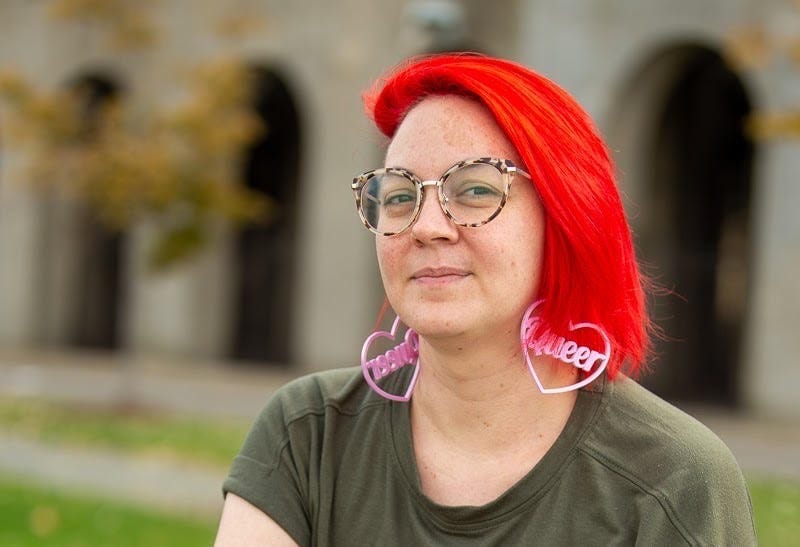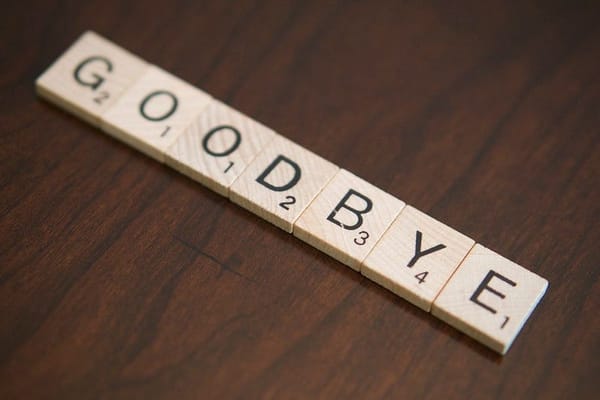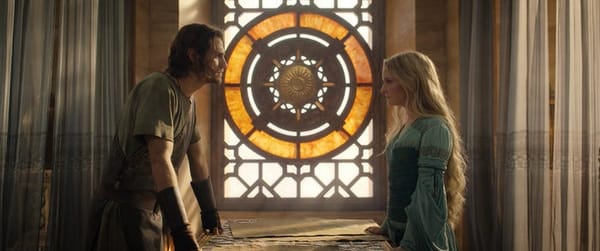A League of their Own highlights the queer history of women in sports
A Q&A with journalist Frankie de la Cretaz

I recently binge-watched the new Amazon Prime show “A League of their Own” and loved it. It was really cool seeing a show based on a story that we knew thanks to a hit Hollywood movie from the nineties that wasn’t afraid to explore the queerness of the players of the time.
I was interested in how accurate the show’s portrayal of queer women’s baseball players in the forties, so I spoke with my friend Frankie de la Cretaz, who has devoted their life and career to documenting the history of queer women’s athletes.
De la Cretaz has written many articles on queer athletes, and teamed up with Lindsay D’Arcangelo to write “Hail Mary,” a book that tells the story of the National Women’s Football League in the 1970’s. Without further ado, here’s our conversation:
Katelyn Burns:
Your work was cited the showrunner as inspiration for the new A League of their Own show on Amazon Prime. What do you think about that?
Frankie de la Cretaz:
I think this part of the history of the All American Girls Professional Baseball League has needed to be told for a very long time. I love the Penny Marshall film as do a lot of us, but I think one of the most frustrating things for me about watching it is just how straight washed it is. You can’t get a full impression of this league without telling the stories of the queer women who played. I will say what’s really interesting, I don’t know if you’ve seen the interview with Rosie O’Donnell who makes an appearance in this series talking about how she had conversations with Penny Marshall about her character Doris and the original film and Rosie believes Doris was gay.
And there’s that one scene where she rips up the picture of Charlie, her boyfriend who I always, I’ve always taken that to be subtext. According to Rosie, Penny Marshall said it wasn’t and according to Rosie, it is. And I think there’s something affirming to me about hearing Rosie say, “No, my character was queer even if I wasn’t able to explicitly say that in the film,” and then to allow this series to fill the gaps in storytelling that happened.
KB:
Based on your research, it seems like a lot of the players were queer back then. Tell me about what finding that out meant to you as a queer person and a reporter who obviously dedicates your life to covering this stuff.
FDLC:
Well, I wasn’t surprised, but I will say it’s really important when you do this kind of historical research to know that queerness doesn’t necessarily look the way we’re expecting it to look now. So while some of these players spent their lives with women and were openly queer in the ways that they could be, we’re talking, this league was in the ’40s and ’50s, a lot more players probably were queer but were not able to live openly or never came out.
So when I was going through trying to tell this story, it’s funny, I interviewed Maybelle Blair, who consulted on this show, and she came out right before the premiere. She’s 95 and I’m so proud of her, but she did not come out to me when I was interviewing her. She was very much like, we don’t talk about that. The players that I found that were queer were in their obituaries. That’s actually where I found their names. That was so exciting and so affirming. What I had to do was search for beloved companion and read the subtext in player obituaries to even identify who those players might have been. Maybelle Blair estimated [that] 60% of the league was queer.
There is this instinct to heterosexualize women’s sports in this way, but it’s really important to know that women’s sports history is also a queer history and it’s very exciting to me to see that part of the narrative being put back in place.
KB:
One of the themes in both the movie and the show is both do a good job of exploring the pressure to be feminine while also being an athlete. Do you think there’s lessons to be learned from that in how we think about women athletes today?
FDLC:
Yeah, so I think it’s really important to recognize that the pressure on women athletes to be feminine is rooted in homophobia and transphobia. Those things can’t be separated. So even if we look at this league and as we see in the movie and the series and as actually happened, these players had to play in skirts. They had to attend charm school. They had to wear makeup on the field. That was explicitly done. It’s often written off as “a product of the time,” but actually it was very intentional to try to avoid the women being perceived as lesbians, which we know a lot of them were. That part we don’t often hear about, that motive. There were no fraternization policies and things like that too, to really prevent this from happening.
Aesthetically, you have a lot of things happening as to why women athletes have historically been pressured to be feminine. You have a lot of Victorian era anxieties about the role of women and how their role in society is to have babies. The fear that physical activity is going to make them infertile or damage their reproductive systems somehow. This fear of masculinizing women is actually much more about gender roles in society. It’s rooted in that homophobia and transphobia and the things that would prevent women from fulfilling what was seen as their role as incubators.
It also becomes a double edged sword when we look today. Now you’re much more likely to hear that in order to attract an audience, and by audience, they mean men to women’s sports, there must be something that needs to appeal to those men. Of course it couldn’t be the athletic skill of the athletes, it must be their looks. You have this other thing happening where women athletes are pressurized to conform to standards that would appeal to the male gaze. The argument is that’s how you draw men into playing women’s sports. I think that’s kind of the more insidious one.
We see that in big and small ways in terms of who gets sponsorships, which athletes are the face of a league? It’s more likely feminine players or more conventionally attractive players are going to be the ones who benefit in that way. We still, as much as we want to say that we’ve come a long way, there’s still a lot of ways in which success as an athlete cannot entirely be divorced from a person’s looks when that really shouldn’t have any bearing on their success in the athletic world.
KB:
No, it made sense to me. So you wrote a book with Lindsay about professional football, women’s professional football, but that was from a later time period, right?
FDLC:
Yeah, the ‘70s.
KB:
How would you say things changed between the ’40s, the Maybelle Blair era of the All American Girls Baseball League to the football league that you covered?
FDLC:
I was really curious about this when I did my reporting, because I did the reporting on the baseball league first and I knew there were queer players, but no one wanted to talk to me. So when Lindsay and I started reporting the book, we knew there were going to be queer players. We didn’t know if anyone was going to want to talk about it or if any of them were going to see it as connected to their time playing football. It turned out that we really didn’t need to be worried about that because we’re talking about basically the next one generation later.
What we have happening in the ’70s is the women’s liberation movement culturally is happening. Stonewall had happened a few years prior, so societally, things are different and many of the women, if they weren’t out then are out now, and were willing to talk about that.
It was still not safe or encouraged to be gay but it was not as taboo as it would’ve been in the ’40s and ’50s when you have… There was a Netflix documentary called A Secret Love about Pat Henschel and Terry Donahue. Terry played in the All American Girls Professional Baseball League. They were together for 70 years and in my research when you find either of them mentioned together in the press, they’re referred to as roommates or cousins or best friends in varying capacities. They kept their relationship hidden from their family for nearly 70 years and were just roommates. That’s what being gay in that time period was like. Generations later, it’s still not safe. You still are on the edge of raids of gay bars and things like that. Many of the players in the National Women’s Football League experienced those things, but you’re kind of starting to move away from that a little bit.
The other thing that’s really interesting about this difference is I also think because you have Title IX happened right around then too and there was this big push to get women into athletics. Again, women playing sports of course was still not taken seriously, but people understood it more than they would’ve in the ’40s when it really was a gimmick, publicly. So because you have more examples of women being serious athletes, there was no way those women were going to play in skirts, for example. We have stories from women in the football league saying that, and many of these women were butch and masculine of center and gender variant in certain ways, gender nonconforming, I’ll say. And [then] you have the owner being like, I think we should wear dresses on travel day and he was laughed out of the locker room.
That wasn’t going to happen. Obviously we see a really big difference where versus the All American Girls League, where they had no choice. They were going to in order to play ball, they were going to, or that skirt. What I will say is we still aren’t entirely removed from that because you can actually look to football and the lingerie league of football that a lot of, if anyone knows about professional women’s football in any capacity, they know about the lingerie league because it’s the only, it was until recently the only women’s football that ever had a TV deal. And that’s a really good example. Those women are serious athletes who love football and many of them are willing to play football in their underwear, if it means they get to play. We can still see that we’re not entirely away from that, but I will say that there were definite differences between the ’70s and the ‘40s.
You can find Frankie’s work on their Twitter, @ thefrankiedlc. You can also find bonus content from this interview over on my Patreon for $5/mo subscribers.
If you appreciated this piece, consider contributing to my Patreon to support more work like this.



